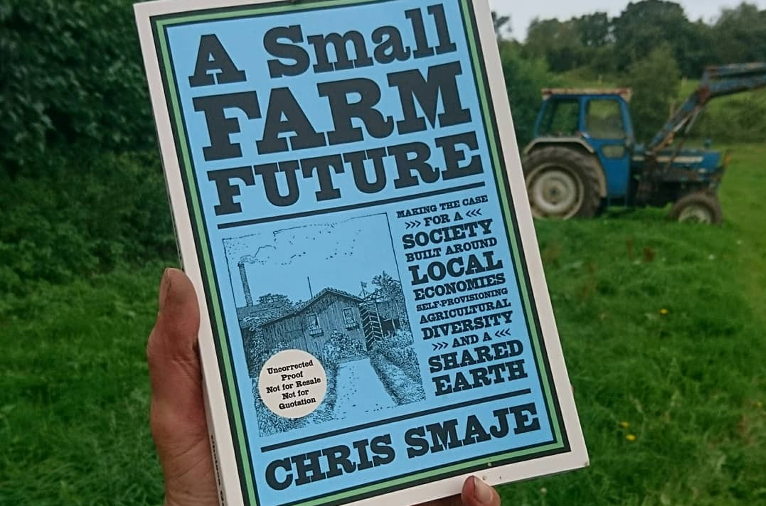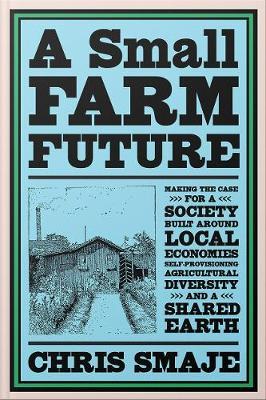(Brace yourselves, dear reader, for a lengthy subtitle … see you on the other side):
A Small Farm Future: Making the Case for a Society Built Around Local Economies, Self-Provisioning, Agricultural Diversity, and a Shared Earth
(good to see you again!)
is the long-awaited full-length motion picture version of a long-running and widely-read blog series by the same title. Its author, Chris Smaje, is a small-scale farmer himself, who for the past 15 years has run a small CSA-type operation just outside the town of Frome in the eastern part of Somerset, England. Over the past couple of years, since he signed the contract for the book, Small Farm blog followers (like myself) have occasionally wondered how Chris was able to write the book, keep up with the blog, and also stay on top of things at the farm. In the acknowledgements page of the recently published book, he writes: “I owe an ironic apology to my neglected garden, as I busied myself instead making a case on paper to tend the soil.”
Take heart, readers, take heart Chris: The garden will come back next season, and the book was certainly well worth the wait. Many of the blog entries are little masterpieces of the genre. But while those who have read the blog can trace the origins and evolution of much of what is now in these 20 chapters, the book is far more than the sum of its blog entry parts. There is a fully developed architectural unity, a very carefully constructed argument, and much that is genuinely new.
So, what kind of a future does this book envision, and how does it differ from the past and the present?
Let’s start with the present: The extended opening chapter with the title “Ten Crises,” which reviews some of the well-known existential crises faced by our civilization as it moves forward on its current trajectory. There are sections on the climate crisis, over-population, over-consumption, biodiversity loss, and the other familiar issues that presently weigh on people’s minds in these early decades of the 21st century, and for which there are no easy solutions other than a complete rethinking of the project of civilization itself.
It is refreshing to read a book that begins with the premise (less and less controversial as time goes by) that we cannot preserve any form of civilization without fundamentally changing the way we live. There is no beating around the bush: The small farm future that Smaje contemplates is essentially a post-collapse world. These ten crises are therefore not just “problems to solve,” but signs and symptoms of a deeply unsustainable civilizational model that is moving steadily toward collapse. Smaje acknowledges that a deus ex machina technological fix is within the realm of possibility; but it is extremely unlikely and, in any case, will not address the underlying logic of the system that created these crises in the first place. It is not the end of the world that lies ahead of us; but it will very likely be the end of this world.
The Ten Crises chapter is also about the ways in which a capitalist consumer mindset has given us a limited and biased conception of these problems. Smaje challenges the premises of modern-day conscientious consumerism (what he calls “shopping aisle ethics”):
“[T]he small farm future I’m describing isn’t the same as a green consumerism future, where shoppers with lives much like the ones most people live in rich countries today buy their food in stores like the ones they shop in today, except that the food is more local, more sustainable, more organic, or whatever … it’s a future where you or your descendants are trying to figure out how to furnish your needs from your locality, probably by furnishing many of them for yourself, because you have few other choices” (p. 9)
And while this may sound at first like a bleak vision of a hardscrabble future, that is not what Smaje hopes for and has in mind:
“There certainly may be some dystopian or apocalyptic futures awaiting us unless we play our present hand of cards with skill. But a small farm future only represents a decline from the large farm present if you consider the latter to be a lofty civilizational summit to which humanity has laboriously climbed. That’s a view I resist. If we play our cards well, the small farm future I describe here could make for a much more congenial life for most of the world’s people than the one they experience today. But we do need to play them well.” (p. 9)
Most of the book is dedicated to exploring various ways of “playing our cards right.” And a fundamental premise of the subsequent exploration is that in the real world, as in the garden, there are no simple solutions to problems; there are only trade-offs.
Part 2 of the book, titled “Small Farm Ecology,” contains what are perhaps some of the least original parts of the book, consisting of brief chapters that touch upon agroforestry, the role of animal husbandry in the small-scale farm, etc.. One thing I do regret is the absence of Smaje’s wonderful analysis of the energy efficiency of the scythe, which was published as a blog entry. There is a chapter titled “Can Alternative Agriculture Feed Us?” (The short answer is yes, because we will have few other choices…). All of the issues covered in Part 2 have been dealt with at greater length and in greater depth by other authors, and Smaje only touches upon them here (briefly, though intelligently). Part Two is full of insights and thoroughly worth reading, but in the remainder of this review I will focus my attention on the truly remarkable second half of the book (Parts 3 and 4).
Smaje nowhere mentions the word “prepper,” a term that is hard to avoid in discussions on adapting to a post-collapse world. There are good reasons for avoiding it. “Prepping” is a problematic term designating a problematic mindset, one that invites us to indulge in survivalist fantasies of absolute autonomy and self-reliance, with the added bonus of relieving us of the burden of social or political obligations. But as Smaje reminds us, a re-localized and decentralized small farm future will almost certainly force us to consider questions about political and social justice with even greater sense of urgency.
A small-farm future will likely mean not only a redistribution of land ownership, but a different distribution of people. Not everyone will be able to localize in the place where they currently find themselves, in the urban centers of consumer capitalism where the grocery stores have three days’ worth of food on the shelves. Those expatriates/refugees from the city will need to find a secure place for themselves and find ways of getting along with their new neighbors.
These are daunting challenges, to put it mildly. How will this cultural and political transformation play out in the coming years? How can we abandon our modern liberal progress narrative but still preserve the civic virtues and “progressive” values we hold dear? And, even more important, how can we treat this as an opportunity to transition to a more just society, one based on a deep sense of what Smaje calls “non-hierarchical decency”?
In the nine chapters that comprise parts 3 and 4 of the book, Smaje tries to paint an honest picture of the challenges we face in reimagining civilized life in a decentralized world. Each of these highly complex issues deserves a book-length treatment; Smaje knows this, and his task here is simply to map out some of the issues that we should not relieve ourselves of the burden thinking about. While his discussion is informed by present hopes and ideals, it is also grounded in a non-utopian recognition of our problematic history and its unresolved (and never fully resolvable) tensions and conflicting interests.
A good amount of space is devoted to the vexing problem of land rights and land access. Smaje reviews a number of redistribution models – the Usufruct system, the idea of the commons – as well as policies such as inheritance laws that will obviously require the existence of some centralized system of enforcement.
There is a fine chapter on politics at the household level. Smaje considers how a small farm future might transform traditional gender roles … or, if we are not careful, how it might revive and reinforce an imbalance of power that we have seen in patriarchal cultures. While most small-scale farmers in the world right now are women, Smaje points out that this is no model for the future if women are unequally burdened with most of the work on the homestead (which is now often the case).
On the other hand, most of the work that will need to be done in the future (by men and women) falls into the category of the “care economy” and is work that has traditionally been characterized as feminine and maternal: animal husbandry, plant cultivation, caring for children and the elderly and the sick.
In the climactic chapter of the book, aptly and ominously named “Dispossessions,” Smaje attempts to comprehend past, present, and future within a single vision. At the heart of this brief but intense chapter is the question of how to conceive of a localism that is not a nativism. Smaje shifts briefly into personal narrative mode, considering “the ghosts of class conflicts past” that still haunt the countryside where he lives and still inform some common attitudes toward outsiders:
“I feel these ghosts around me as I work my holding—family ghosts of ancestors who left the land as labourers … But I also feel the different ghosts of an occasionally hostile localism directed at a stranger like me born and raised into another emptied farmscape fully a hundred miles from where I now live and where, even there, other people still had a better claim to be a ‘real’ local than me.”
Smaje argues that we need to bury these ghosts as we move into a future already haunted by uncertainty. This is sentiment that I fully share, though it is of course easier said than done. As William Faulkner famously noted, “the past is never dead … it’s not even the past.”
In my own country, the one where Faulkner’s ghosts still roam about, it is impossible to imagine a post-collapse future without also pondering all of the mutual animosities that now exist between various groups of people, with the fault lines often coinciding with the urban/rural cultural divide.
The historical precedents are not particularly encouraging. The Homestead Acts, the most radical land reform measures in United States history, ended up being early experiments in the “redlining” and further disenfranchisement of African Americans. In more recent history, the Back to Land movement of the 70s coincided in this country with the “white flight” from urban centers. And in even more recent history, pre-existing social inequalities have been on display this past year in the post-COVID-19 exodus from the cities to the countryside undertaken by those who have the means to do so (which raised concerns about “rural gentrification” and the dynamics of crisis-fueled internal migration).
All of this suggests that we have a lot of work to do at the cultural and social levels. That is the central and sobering message of the second half of Small Farm Future, and Smaje—a social scientist by training—faces these issues head on and discusses them in an admirably honest way.
Part 3 of the book commences with Chapter 16, titled “From Religion to Science (and Back)” – a intricately argued and subtly paced chapter that (for me, at least) requires multiple readings to fully appreciate its many layers. It fully repays the effort of re-reading. Smaje opens this chapter by shifting the focus from big-picture issues to more intimate questions about value and meaning and day-to-day lived experience. A small farm future is likely something we will need to adapt to, whether we want to or not. That is one of the premises of the book. Smaje acknowledges, however, that making a virtue out of what is in any case necessary will not suffice. What we need, Smaje argues, are new stories, new poetry, and values of a more intrinsic and spiritual nature:
“[A]ny vision for the future has to engage individual motivations more personally. It has to work like a story or a song of life: this is who I am, this what I do, this has meaning.” (p. 215)
If I have any criticism of Smaje, it is that while he takes the power of religion and the power of storytelling seriously, he does not fully connect this recognition with his far more emphatic critical distancing from stories that capture common desires for authentic living and nostalgic yearning for a past that never existed. “I want to tell a story about going ‘forwards’ into an agrarian future,” Smaje tells us, “not going ‘back’ to an agrarian past.” (p 216) Fair enough. Methinks, however, that Smaje doth protest too much. If you want to disabuse people of their problematic pet notions (such as “prepping”) and poo-poo the jargon of authenticity, then you need to have some equally compelling notions on hand to take their place. Most people sitting at their laptops, unhappy with their sedentary jobs, do not stare out the window daydreaming of things like “self-provisioning” or reflecting critically upon the concept of “the wild.” While Smaje is absolutely right about the danger of romanticizing the past and rightly distances himself from easy appeals to simplicity and authenticity, the established language of “back to the land” and “self-reliance” and “private edens” nevertheless has a power that cannot be dismissed. (I would also point out that Biblical stories about a return to an imagined Promised Land were adapted by the rhetoric of the Civil Rights movements to powerful effect.)
An alternative to the story of unlimited growth and linear progress would involve some story about working within limits—which, of course, is the beginning of tragedy and comedy, as well as traditional morality. “Live within your harvest” is the motto of many a homesteader, and as Wendell Berry observed, “a morality without limits is no morality at all.” But frugality and morality and politics are one thing; the meaning and value-generating stories we tell ourselves and identify with, the songs we sing to and dance to, are a fundamentally different matter. We do need to “reconstruct our desires,” as Barbara Kingsolver recently put it. But that project is best understood as an exuberant Nietzschean call for radical value creation by embracing limits, rather than a Puritan demand for sacrifice and self-restraint and resignation.
Throughout the book, Smaje does make a strong cumulative case for thinking of limits in this value-generating way. In fact, it is an integral part of his critique of deep ecology, rewilding, and decoupling, all of which are based on the widely held conviction that nature has an intrinsic and given value. Smaje challenges this assumption, arguing that these values are not simply out there and “given” but come about through rituals and practices by value-creating humans interacting with nature.
This is a central and important theme in the book. But it is also a subtle and gradually worked out theme, and I wish it were a bit more in the foreground (like the discussion of trade-offs that opens the book). I cannot help but think that had Smaje given this anti-foundationalism more emphasis, he might have spared himself the need to devote so much space and energy to qualifying himself and making it clear what he is not saying (with regard to nostalgia and ‘turn-ing the clock back,” etc.)
These are minor quibbles about the exposition of a powerful and extraordinarily complex argument. Not even a long book review can begin to do justice to its longer-form subject, and that is particularly true with a book as densely argued and as carefully constructed as Smaje’s. If you are looking for easy answers about the One Thing that will solve all our problems, then there are plenty of books and documentary films out there that will satisfy that need. But if you seek instead the consolation of clarity and honesty and real-world complexity, and you want to begin the important work of imagining a positive future worth bringing about, then Smaje’s Small Farm Future is an essential read for these times.







